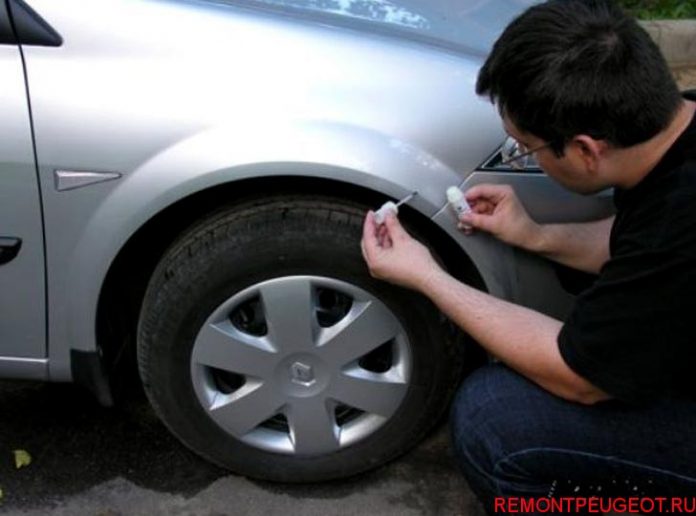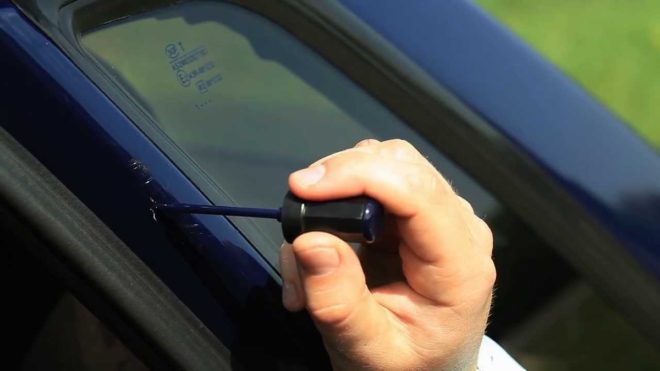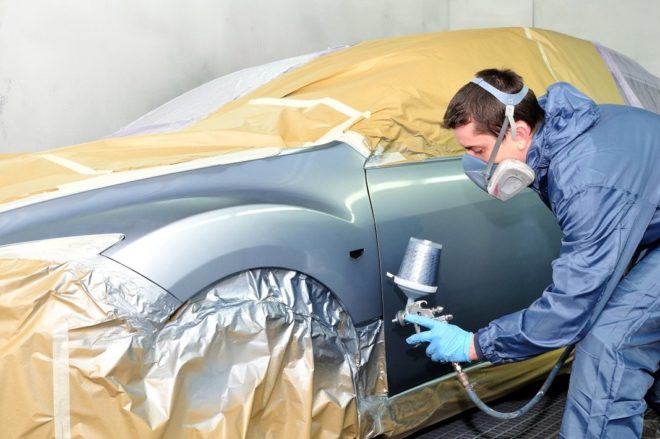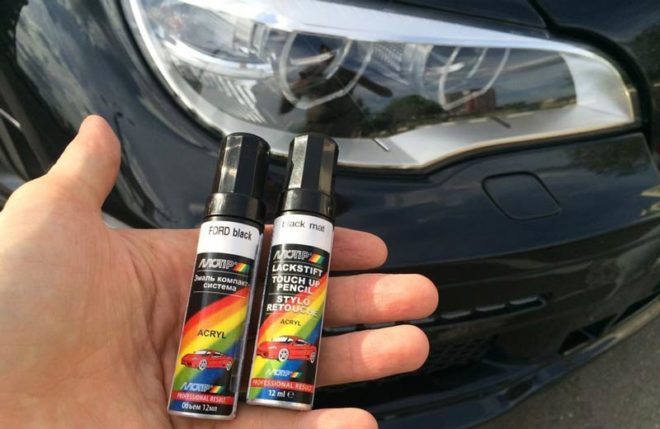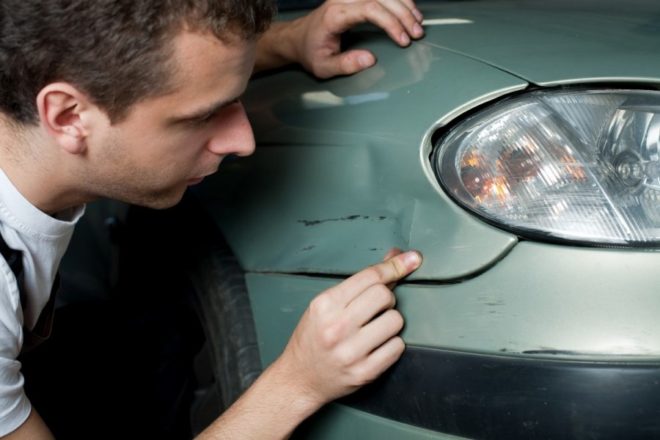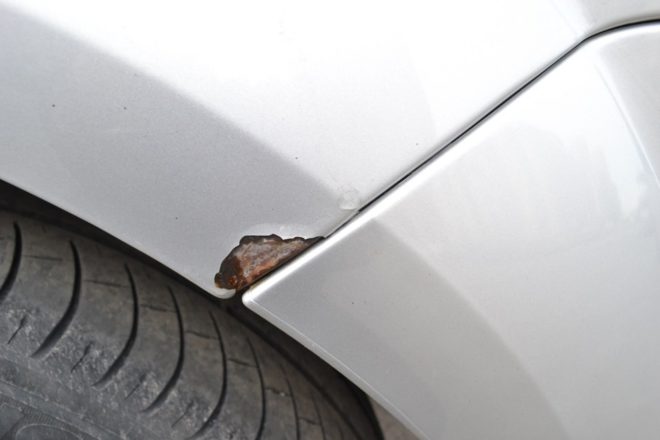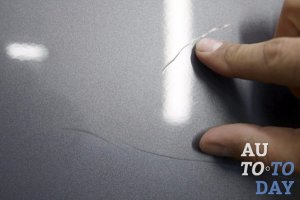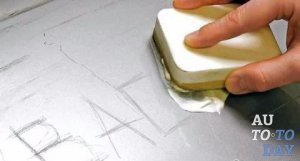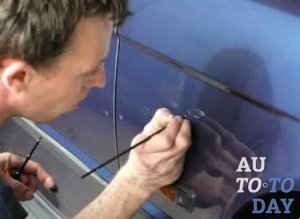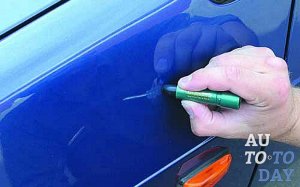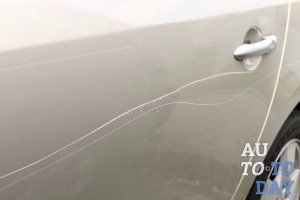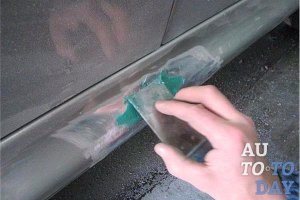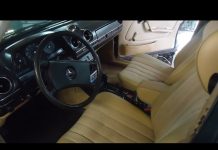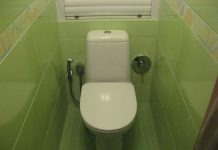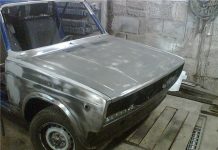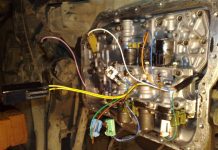In detail: do-it-yourself repair of chips on a car body from a real master for the site my.housecope.com.
Welcome to the my.housecope.com/wp-content/uploads/ext/2102 blog!
In this article, we will consider how to remove chips on a car with your own hands.
A lot of stone chipping looks terrible, especially on dark colored cars. Even worse, chips break the protective paintwork and contribute to the appearance of rust in these places. After a while, rust can grow in depth and diameter and be difficult to remove (see the article on repairing corrosion), so it is best to repair chips as soon as possible from the moment they appear.
Chips appear due to stones flying during movement, which fly out from under the wheels of other cars. The more distance you keep from other vehicles, the less chipping will occur.
Stones don't fly out from under the wheels of other cars like bullets, they just move up a bit and don't have much acceleration. All the force of the impact, due to which the chip occurs, is given by the speed of your car. Thus, the faster you drive and the shorter the distance, the greater the likelihood of chipped paint.
In modern cars, the paint can be an independent protective coating (acrylic paint without varnish) or varnished paint (base + varnish). To be more precise, first a primer is applied to the metal, and then a base (a thin layer that gives color) and varnish (the thickest layer that gives protection).
Chips can be of three types - damage to only the varnish (if the paint is varnished), damage to the varnish and paint to the ground, and damage to all layers to the metal.
| Video (click to play). |
- Depending on the type of chipping and type of paint, different materials and components may be required. It can be either a scratch/chip corrector (for very small chips) or a bottle of paint matched to the code, primer for metal and varnish in the same bottle (for varnished paints). Paint from an aerosol can can also be used, which has certain features, which we will discuss below.
- The brushes that come with the bottle for touch-up paint are usually made of plastic. They do not absorb and hold paint normally and "capture" a large area when applying paint, so they are inconvenient when repairing small chips. It is better to buy a small brush for painting with natural bristles and a thin tip. This will make it easier to paint the chips, as it gives you better control. The tip of the brush should be shaped like a V to hold the drop of paint. Brushes can be bought in different sizes from the smallest to 5 mm. They are useful for filling paint chips of various sizes.
- To prepare medium and large chips for repair and to smooth the paint that filled the chip, you need to prepare sanding paper P600 / P800, P2000. On the eraser located at the end of the pencil, you can glue P600 or P800 sanding paper with superglue (can be cut or made with a hole punch). With this mini sanding block, it will be convenient to smooth the edges of medium and large chips and, if necessary, clean off the rust inside the chip.To smooth the dried paint after filling the chip, you can use sanding paper P2000 wrapped around a school eraser.
- Abrasive polishing paste to restore gloss, in case you decide to apply the leveling of excess paint by sanding.
- Carefully inspect the body of the car and look for places where there are chips. Most chips are usually found on the front of the car, near the headlights and grille. Also chips can be on the mirrors and the bottom of the doors.
- If the chips are very small, then you can use a special pencil (corrector) of a similar color. Chips of medium and large size cannot be repaired with a corrector, this requires paint.
- Wash and dry the surface of the body before starting chip repair.
- For large chips, use P600 or P800 sandpaper to smooth the edges and clean out the cavity (use an eraser on a pencil with sandpaper glued on for ease). The beveled edges of the chip will allow the paint to spread more smoothly and reliably. You will get a smooth transition from the old paint to the new one and the chip edge will be less noticeable after the paint dries. You can "capture" the area around the chip a little. If soil remains inside, you need to try not to clean it off.
- If there are several chips on the car, and there is no experience in repairing them, then to start the repair it is better to choose a chip in the least noticeable place.
- If the chip passes through all layers of coatings to the metal, then a primer must be applied before the paint and allowed to dry. It will help increase adhesion, and the paint will stick more reliably.
- The paint must be mixed well before use, as this may affect its color. Place a small amount of paint in some container, from where it will be more convenient to take it with a brush or a toothpick / match.
- If the ambient temperature is low, then you need to use a hair dryer to heat the surface. The paint should flow easily inside the chip. The cleavage cavity can be filled in stages, over and over again. Use a hair dryer to speed up the drying of the paint between coats.
- The paint inside the chip must be applied from the center to the edges. Dip the very tip of the brush or toothpick into the paint so that a small drop forms at the tip. Place this drop in the center of the chip. Large cracks must be filled in stages. First apply one layer, wait at least 30 minutes, then apply the second layer. Thus, it is necessary to fill the entire cleavage cavity and so that it is above the level of the entire adjacent plane. The paint will settle a little after drying, so it needs to be applied more than necessary.
- After drying, excess paint must be sanded with water using P2000 sanding paper, always with a hard block (you can use an eraser for this). Just sanding paper will not work to level the paint to the level of the entire surface.
- When grinding, it will be clear whether the repaired chip is on the same level. This requires the water to dry after sanding. The surface must be evenly matte. If a recess remains, then paint or varnish can be added and sanded after complete drying.
- If you leveled the chips by grinding, then to restore the shine of the paint, you need to use a polishing paste with a special polishing wheel, or a polishing cloth. You can read the detailed article “do-it-yourself body polishing”.
- Some colors are more visible after chip repair than others.On a red, black, white, blue, green car, it is easy enough to make the chips invisible. Light "metallic" and "pearl" are much more noticeable after repair.
- Lacquer is used when a chip is repaired on a car covered with varnish and paint. Lacquer provides basic surface protection.
- If you plan to apply varnish, then when filling the chip with paint, you need to leave room for varnish.
- Each coat of varnish must dry for at least 30 minutes before applying the next.
- Some paints that are sold for chip repair can be mixed with varnish, then no varnish needs to be applied over the top.
If using paint from a spray can, shake it thoroughly and spray it into a small container. Next, dip a toothpick or brush into the paint and spread the paint inside the chip, starting from the middle. Repeat application at intervals to dry. As a result, the paint should be slightly higher than the overall surface, as it will settle after complete drying. You can finish at this stage, or continue leveling the applied paint by grinding. This is best done after 1-2 days, depending on the thickness of the paint and temperature conditions.
One method of chip protection is to use a protective film (such as 3M VentureShield) on the most chip-prone areas. It is transparent and thick and soft enough to repel the impact of stones, but turns yellow over time.
Another way to protect the hood from chips is a special plastic lining. Its drawback is that some of the stones that fall on it can, like on a springboard, rise and hit the roof.
When driving a car, small scratches and chips appear on the surface of the body. They spoil the appearance of the vehicle, and are the focus of corrosion. Well, rust destroys the bodywork of the car. To solve problems, you need to know how to tint chips on a car yourself.
Small chips and scratches are fairly easy to fix. However, before carrying out the restoration of the paintwork in small areas, it is necessary to prepare:
- Drive the car to a heated and well-lit area.
- Wash and degrease the treated surface. At the same time, gasoline should not be used as a degreaser, as it can damage the paintwork of the body. For application, a fiber-free cloth is used.
- After degreasing, coloring compositions are applied to small defects (they are used to paint chips) or a special pencil is used to remove scratches, but around large damages they are polished, the place is treated with a primer. In some cases, putty is used to even out small dents.
Upon completion of the preparatory work, proceed directly to the restoration of the paint on the car.
Minor damage is easy enough to remove with your own hands at home.
When painting over chips on a car, you need to determine the nature of the damage. If these are shallow defects, then you can use a polishing agent or a pencil. After surface treatment, the damage is almost invisible. If the chips have a recess, then the recovery process is carried out as follows:
- A primer is applied to the prepared surface.
- The dried primer is applied with a paint identical to that with which the vehicle body is painted.
- After staining, a small layer of varnish is applied, it hides artistic defects, and makes the tinted area almost invisible. Well, processing the area with a layer of wax will give it a glossy sheen.
To choose the right shade of paint, turn to the services of a colorist.However, the shade code can be found in the technical documentation for the car.
If there are many chips on one part, spot painting will not solve the problem. The dye applied with a brush will be quite noticeable. For more effective repairs, local body painting is performed.
The part is dismantled, washed and degreased. After drying, it is completely polished with a polishing machine (coarse-grained discs are used first, after which they are changed to fine grain). Some areas are treated with sandpaper. An acid primer is applied to the surface. After it dries, an acrylic primer is applied. If the part was damaged, an epoxy primer must be applied over the acrylic, it gives the surface mechanical strength.
After the primer dries, the part can be painted. The painted part of the body, after the paint has dried, varnish is applied. At the end of the restoration of the paintwork, the place of repair is polished.
If the body part cannot be dismantled, entire sections of the car body are pasted over with newspaper and masking tape.
If a part of the car is covered with a small number of small chips, and there are no signs of corrosion, then you can tint the chips on the paintwork of the car with your own hands. It won't take much time and effort.
The chips are tinted with a soft artistic brush, then varnish or enamel is applied. So get rid of shallow damage. If the chips have indentations, then the recovery algorithm looks like this:
- Prepare the surface for work.
- Apply a primer to the chip, let it dry. Grind.
- Paint the restored place, apply varnish.
Only wet grinding can perfectly level the surface to be treated. To do this, the area is sprayed with water.
If you do not pay attention to damage to the paintwork for a long time, metal corrosion occurs. It is impossible to remove rust from the body with a pencil. If corrosion occurs, it will need to be removed, and only after that, proceed to eliminate chips. The algorithm of work performed is as follows:
- The damaged area is cleaned to the metal. This applies to both large and small damage.
- The place affected by rust is treated with a corrosion neutralizer and degreased.
- The surface is primed, sanded, varnished, and polished.
If there are dents, they must be repaired. To do this, use special pulling devices and automotive putty.
In order for the shaded area not to be noticeable, you need to choose the right color. To do this, you need to know how to determine the shade:
- The first way is to study the car's documentation. In the technical passport of the vehicle, the painting code is indicated, it can be used to find the coloring material of the desired shade.
- If the documentation for the car is not available, you need to dismantle the gas tank cap and go to the store. There, the color is selected according to the desired paint.
- An alternative would be to use the services of a colorist. A specialist in special patterns will select the exact shade of color.
Painting the surface of the car is made from an airbrush or spray can. The paint is applied to a dried, fat-free surface in a dry closed room. If dust or moisture gets into the treated area during painting, the painting will be damaged. After touching up the bodies, with the type of metallic or mother-of-pearl color, polishing is performed, which almost completely masks the restored area.
Tinted areas after drying are visible to the naked eye. To correct this defect, they need to be polished. This operation is performed using a grinding machine and special milk.
Ways to polish the car body after painting have a number of nuances:
- Grinding is carried out with sandpaper soaked in water with a grit P1000.
- The next step is to use a sandpaper with a finer P2000 abrasive.
- At the place of polishing, a matte and smooth surface is formed. To give shine, polish with a grinder with coarse abrasive paste.
- The result is fixed with a medium abrasive polish.
- At the end of the work, the surface is treated with polishing milk and a soft grinder.
Minor damage to the paintwork of the car body does not cause concern for many motorists, but they are the cause of more serious problems. To avoid costly repairs, small chips and scratches must be removed promptly. Major damage can be repaired at home, so you can save a lot.
- Repair of chips and scratches on the car body: which method to prefer
- Do-it-yourself repair of scratches, chips on the car body
- Working on chipped paint
- Stages of repairing a scratch or chip on the body
- Materials for repairing scratches and chips on the car body
- Budget calculation
This moment is quite unpleasant for the car owner, not only because the car loses its aesthetic appearance, but also because it is in the places of scratches and chips that corrosion and rust begin to develop.
Therefore, it is very important to get rid of such small damages as soon as possible, since delaying repairs will lead to even greater monetary costs. You will learn how to fix car body scratches and small chips yourself from this article.
One of them is polishing the surface of the body. This work can only be done if the scratch has not reached the ground level. For polishing, you will need special pastes that will help remove a thin layer of paint in the place of a scratch and level it to the same level.
In this case, it must be remembered that the car is not painted, but rather, a layer of paint is removed. It will require accuracy and care, because you can overdo it and polish to a layer of soil. Then you have to paint not only the scratch, but the entire place of polishing. And this will lead to additional costs of money and time.
At the same time, it should be remembered that before using a wax pencil, the car must be washed with high quality, and the place of the scratch should be cleaned with gasoline or white spirit. Removing a scratch with a wax pencil is quite easy. If the scratch did not affect the layer of soil, but in itself is very wide - here you will not get off with polishing and a wax pencil.
In any case, you have to paint. It will be enough to paint only a scratch. To perform this work, you can glue the scratch on both sides with adhesive tape or masking tape. To apply paint, you can use a brush with which girls paint their nails. The main thing is to pre-wash it thoroughly in acetone, and thin out a little.
If the scratch has touched the soil layer, there are also two possible solutions to this problem. The first is only suitable for very thin and small scratches. It consists, as in the previous case, in covering scratches with a wax pencil. Again, do not forget about the pre-treatment of scratches and washing the car. But don't be fooled. This method has one big drawback.
Over time, the wax layer will begin to disappear, and the scratch will become more and more noticeable. Therefore, such processing will have to be performed again and again at certain intervals, and in order to avoid this, it is best to tint the place of the scratch. In this case, two layers of paint are applied after preliminary preparation.
If you notice a wide scratch that has reached the ground, forget about the wax pencil, it will not help in this matter. Here, only painting the damage site will help out.
To do this, the place of the scratch must be washed and treated, as mentioned above, with gasoline or white spirit. Then it does not hurt to glue the problem area with adhesive tape around the perimeter and apply two layers of paint. This method is much more reliable and efficient than a wax pencil, and it is done only once, unlike the first.
What if the scratch went through the top layer of paint, a layer of primer and got to the metal? Although this damage is one of the most annoying, there are also ways to repair it. Here you will not get off with ordinary painting, and even more so with a wax pencil. First of all, as in all cases, the car should be thoroughly washed with foam and dried.
Then the standard process - treatment with white spirit or gasoline. After that, wipe the car again in the place of damage, first with a damp, then with a dry cloth. If elements of corrosion are already visible in the place of the scratch, the next step will be the application of anti-corrosion primer.
In no case should this element be omitted, since painting a deep scratch without an anti-corrosion primer can lead to unexpected results.
Corrosion and rust will continue to develop under a layer of paint, and will soon nullify all your efforts.
Sometimes car owners have problems with parking, in which bumpers often suffer. Therefore, scratches on bumpers are a fairly common problem that cannot be ignored.
The plastic bumper is not subject to corrosion and rust, so everything is simple here - cleaning from dirt, treating with gasoline and tinting with acrylic varnish from a repair spray or paint.
If your car has metallic paint - everything is the same with one small feature. It lies in the fact that such a colored layer has a little more shine, which sometimes becomes very noticeable. To eliminate this problem, the painted area is covered with a thin layer of varnish.
We figured out the scratches, but there is another common problem with the car body - chipped paint.Chips of paint, even at a shallow depth, have a fairly large area, so a wax pencil is not used here.
If the depth of the chip is small, it may help to treat the problem area with a color-enriching polish, after which a layer of protective polish is applied.
Before processing, clean and degrease the surface. In the case when the chip has reached the layer of soil or metal, the polish is useless, and tinting the chip cannot be avoided. Some car owners are faced with the problem of swollen paint.
The damage is quite unpleasant, since pockets of rust and corrosion appear under these swellings. Therefore, this problem must be dealt with immediately. To do this, carefully open the vial and remove all remaining paint.
Clean up enough so that the remaining paint is securely held on the car body. If, after opening the bubble, you find traces of corrosion or rust under it, it is imperative to remove it and treat the place with anti-corrosion primer.
Then you can start painting. The paint is applied in several layers so that it is equal in level to the old layer.
We carefully clean the place of the defect from dirt, traces of rust, if any. We clean up the ground. We degrease.
During troubleshooting, you decided which primer you need: for paint or for metal. We apply a primer with a rubber spatula and let it dry. Then we clean up the area again.
That is, all procedures are performed in accordance with the body painting technology, only on a small area.
Before applying paint to the repair site, cover the surrounding surface of the body part with film or paper and masking tape. Apply paint from a spray can in accordance with the instructions.
If you use a “pencil” to repair a scratch or chip, then apply paint in two or three layers. Do not immediately remove the resulting influx. Let the paint dry.
After repairing a chip or scratch on the body, and the paint is completely dry, polish the body at the repair site. Taking into account the fact that the area of damage is small, the polishing of the body can be done without the use of equipment, i.e. manually.
If you have too large a scratch area on the car body, the repair, most likely, will have to be done on the entire body part. Here already one "pencil" is not enough.
In the same way, plastic parts are repaired, with the only difference being that plastic surface products are used.
On the shelves of the store you can find a repair kit to restore the surface of the car. In its simplest form, these are several cans of paint, supplemented with consumables.
Kits are more expensive and include brushes, sandpaper, varnish, masking tape and other accessories. Often stores offer paint tinting to the desired tone. Repair kits for serious chips contain a primer, putty and tools for working with them.
Sometimes in sets you can find compositions for treating corrosion. Anti-corrosion mastic is ideal for repairing cars with significant damage to the paintwork. The last finishing can be carried out not only with varnish, but also with special means that increase the reflectivity of the paint.
The main reasons for the formation of defects are small stones and road sand. They leave multiple, but small scratches. During car diagnostics, it is necessary to evaluate their size and penetration depth.
The matte surface means that only the varnish has been damaged. Whitened body - damage to paint or even soil. The budget will be affected not only by the “depth” of work, but also by the speed of reaction.
Scratches that have reached the metal require immediate repair. The ideal driver should keep wax crayons on hand and fix any dangerous damage as soon as they are found. Timely cosmetic work will save money in the future. Approximate guidelines for determining costs:
- Fix it PRO and New Fix - sets of several pencils, from $ 0.15 to $ 2, excluding shipping.
- A single pencil Fix it PRO (Car Repair Pen) - $ 0.1.
– 5X and 5Pcs – multiple scratches, price up to $7.
- 3M Scratch Remove - deep damage, up to $15.
If you decide to carry out a full cycle of priming and applying paint, then attentiveness will become the main source of savings. Do not save on materials, do not dilute the varnish too much - it may leak.
Paint smudges are formed due to the high humidity of the room. For the same reason, do not use the car until it is completely dry.
Over time, during operation, in almost any conditions, minor defects in the body or bumpers appear on the car in the form of scratches and chips. These paint damages are not only disadvantages from an aesthetic point of view, but also represent a practical danger to the car body. Therefore, it is desirable to eliminate the chips that have appeared as soon as possible. This will protect the car body from the harmful effects of corrosion. Sometimes, even a small chip, which is almost invisible to others, but knowing about it, it constantly “cuts” your eye, causing constant discomfort. Is it possible to fix car scratches yourself? Yes, it is possible, and it does not require high qualifications or large financial costs.
Of course, there is the easiest option - to contact the experts. However, such a seemingly simple operation can be quite expensive, or the quality will be, as they say, even worse than it was, that is, even more noticeable. This also often happens and then you have to pay again and more to correct what you have done. The choice is yours - if you have money and no desire to mess around, then it’s better not to save money, but immediately contact a decent company. The following article is for those who want and can do minor repairs to their car on their own.
With a large amount of damage, it makes no sense to make a spot body repair. Indeed, in this case, your hood or bumper will be covered with spots or dots with a slightly different color, and the process of spot repair itself will be quite long and laborious. In this case, it is better to paint the entire body part. The painting process is quite complicated, but you can do it yourself. However, whether it will be better and cheaper is up to you. Since this will already require special tools, materials and skills.
If the chips are small and there are not very many of them and there is no metal corrosion, this is just what you can quite easily fix on your own.
To protect the car body from environmental influences, manufacturers use multi-layer protection, which is a combination of several different materials. The strengthened structure of such a coating is shown in the figure. In modern cars, iron is preliminarily subjected to additional protection - galvanization. Thickness and quality may vary.
Therefore, when starting to repair, at least two types of minor damage to the car paintwork can be distinguished:
- affecting iron;
- not reached iron.
The fact is that in each of these cases, the restoration of the paintwork should be done correctly in different ways. If the damage has affected only the varnish and paint, for example, a shallow scratch, it is enough to treat the area with a polish to eliminate it. In the event that the violation of the paintwork turned out to be deeper, damaged iron, the repair will be a little more difficult.
There are several different approaches to how to properly paint cracks on car, and each of them has its supporters and opponents.But in any case, paint is applied to the place of damage, which forms a kind of dome above it, and it must be treated with a polish to bring it to the general level of the existing paintwork. This will make the repaired area less visible. Visibility is most affected by the accuracy of paint selection.
Able to remove scratches chips on the car, which affect only the varnish surface of the car and do not reach the paint. These products often have abrasive substances in their composition, due to which the top layer of varnish is rubbed off and the surface, leveling, again becomes supposedly smooth and shiny.
Polishes are selected depending on the size of the scratch. But you should not get carried away with these tools, because you can remove the layer of varnish completely.
They allow you to remove scratches from a car that affect not only the varnish, but also the paint layer. These products fill the damaged surface, thereby protecting it from corrosion.
In addition to the advantages, these products have a significant drawback: after prolonged exposure to water, they are washed off, and if you do not have a standard car color (black, white or red), but, for example, light green with a metallic effect, then the scratch will still be visible .
Eliminates the most serious scratches and chips on the car, which have reached the metal or ground. The restoration pencil is a tube with car paint and a brush.
Colors are usually matched to the vehicle's color code. The scratch remover is the most reliable tool we've reviewed because the paint doesn't wash off and protects the car from corrosion. The only caveat is that in some specific cases it is difficult to choose a tool, since not all coded car paints are in pencils. In such cases, the colors are selected visually according to the catalog with real colors.
If the chip is very small, take a match or a toothpick and apply a drop of paint to the washed and dry chipped area. When the paint hardens a little, you can smooth it out with a small brush. The paint is selected according to the number of the car from the colorists or according to the details of the car (for example, the gas tank hatches). Over time, the paint fades a little, so the method of selecting a car detail is more preferable.
You also need a little varnish and hardener to it. In the right proportions, mix the paint with varnish and hardener. Tint with a small margin. After drying, at least a day, it is polished with a 3M professional polish. Before polishing, it can be trimmed with a two-thousandth sandpaper.
In this case, the repair of the chip will be more difficult and time-consuming, since it is necessary to remove the corrosion processes that have begun and the spread of rust. To do this, you need to use a traditional body repair, which will remove rust and allow you to locally paint over the part without visible differences from the rest of the body.
To eliminate such a chip, you will need sandpaper with a grit of 600, 800 and 1000, possibly putty, primer and paint, as well as tools for their application, degreasing solvent. The workflow in this case is as follows:
- First, it is necessary to clean the local cleavage on the car, taking into account the possible spread of corrosion under the paint.
- Rust must be brushed down to the metal, then the surface should be washed and degreased. Places where corrosion has been removed should preferably be treated with a primer. You can use an acrylic two-component primer from a spray can. It will be required for these works a few drops. A thin brush or a sharpened match is applied to the metal. After 10-15 minutes it is necessary to apply a second layer. After that, they wait about 2 hours until the soil is completely dry, or accelerate it by heating.
- If necessary, apply putty, let it dry and use 600 and 800 grit sandpaper to meet the requirements.
- Degrease the surface again and, if necessary, apply a primer, which should then be washed out with 1000 sandpaper and water.
- After that, the final degreasing and painting of the body part or the chipped area takes place.
The paint is applied with a marker or brush - this operation requires some care. It is not advisable to apply paint in a thick layer, it is better several times, but thinly and accurately. It is best to work in the garage or in the shade, and not "in direct sunlight." If the area is large enough, a sprayer or spray can be used. When painting in this way, be careful not to spray on other parts of your car. To do this, you can use masking tape and old newspapers. After complete drying of the paint, polishing can be carried out.
Many people also apply car polish, believing that such a step will improve the visual quality of car painting. However, under varnish, any difference in paint becomes more noticeable, therefore it is advisable to use varnish only with perfectly matched paint, or not to use it for small local repairs.
According to Dr.ColorChip technology, the paints used in local repairs differ in their composition from traditional repair kits, selected according to the color code of the car. Dr. Materials Formula ColorChip provides the ability to quickly dry paint, without the use of chambers and other dryers. To remove excess paint, Dr. Colorchip Sealac, which is applied to a cloth and polished by hand until excess paint is completely removed, then the stains from the SealAct solution are wiped off with a microfiber towel.
Everything you need is included. Quite quickly and simply - the price of the issue - find out on the Internet. Reviews - various, often do not fall into color. If you choose this option, read more on the forums.
| Video (click to play). |
Naturally, from all the above methods and means for removing chips and scratches, you should not expect a completely perfect result. But if we compare the price-quality ratio and labor costs, then these are quite effective methods and are suitable in most cases.

